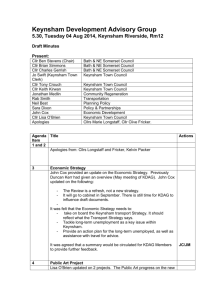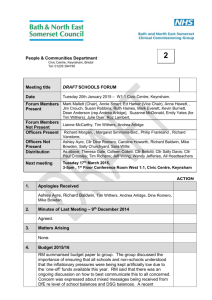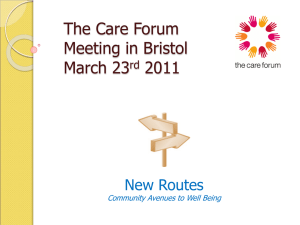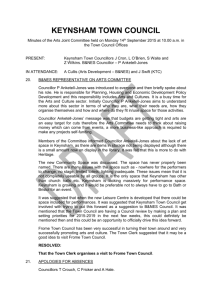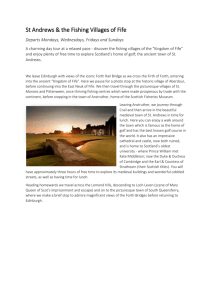Keynsham Area Forum - Bath & North East Somerset Council
advertisement
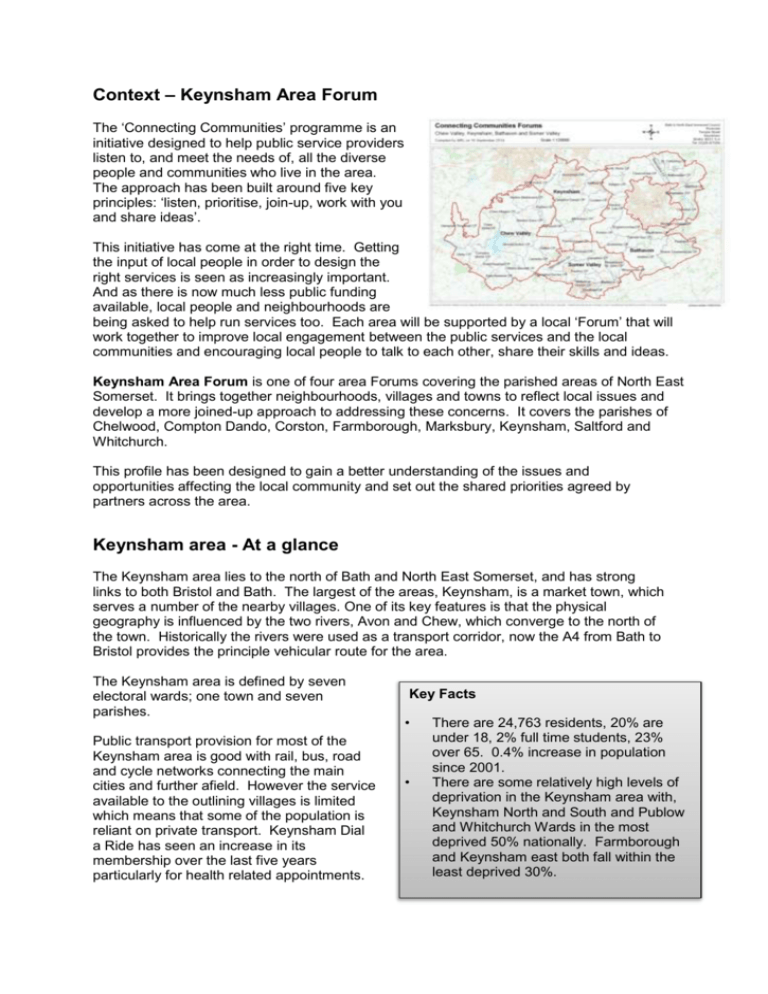
Context – Keynsham Area Forum The ‘Connecting Communities’ programme is an initiative designed to help public service providers listen to, and meet the needs of, all the diverse people and communities who live in the area. The approach has been built around five key principles: ‘listen, prioritise, join-up, work with you and share ideas’. This initiative has come at the right time. Getting the input of local people in order to design the right services is seen as increasingly important. And as there is now much less public funding available, local people and neighbourhoods are being asked to help run services too. Each area will be supported by a local ‘Forum’ that will work together to improve local engagement between the public services and the local communities and encouraging local people to talk to each other, share their skills and ideas. Keynsham Area Forum is one of four area Forums covering the parished areas of North East Somerset. It brings together neighbourhoods, villages and towns to reflect local issues and develop a more joined-up approach to addressing these concerns. It covers the parishes of Chelwood, Compton Dando, Corston, Farmborough, Marksbury, Keynsham, Saltford and Whitchurch. This profile has been designed to gain a better understanding of the issues and opportunities affecting the local community and set out the shared priorities agreed by partners across the area. Keynsham area - At a glance The Keynsham area lies to the north of Bath and North East Somerset, and has strong links to both Bristol and Bath. The largest of the areas, Keynsham, is a market town, which serves a number of the nearby villages. One of its key features is that the physical geography is influenced by the two rivers, Avon and Chew, which converge to the north of the town. Historically the rivers were used as a transport corridor, now the A4 from Bath to Bristol provides the principle vehicular route for the area. The Keynsham area is defined by seven electoral wards; one town and seven parishes. Public transport provision for most of the Keynsham area is good with rail, bus, road and cycle networks connecting the main cities and further afield. However the service available to the outlining villages is limited which means that some of the population is reliant on private transport. Keynsham Dial a Ride has seen an increase in its membership over the last five years particularly for health related appointments. Key Facts • • There are 24,763 residents, 20% are under 18, 2% full time students, 23% over 65. 0.4% increase in population since 2001. There are some relatively high levels of deprivation in the Keynsham area with, Keynsham North and South and Publow and Whitchurch Wards in the most deprived 50% nationally. Farmborough and Keynsham east both fall within the least deprived 30%. The service also runs a number of social events for its members. Unemployment in the area is below the national average. The majority of people are employed, working mainly in managerial, professional, administrational and secretarial roles. 19% of the population is retired, this is higher than the national average. The main mode of transport to work is by car or van, travelling distances of between 5km and 10km to work. There are two secondary schools and nine primary schools that serve the area. Broadlands Secondary and Wellsway Secondary are now Academies. Wellsway Secondary school specialises in Sports and Science and accommodates a leisure centre that is available for wider community use. Key Facts • • • • • • • • Keynsham Dial-a-Ride has approximately 1,200 members. Over 50 groups now use the service. 32% economically inactive, of which 19% are retired, higher than the national average. 29% of people have a degree level or above and 20% of people have no qualifications. 1 in 3 children are aged between 5 and 6 years. 1 in 4 children aged 10 and 11 are overweight or obese. 8.5% of lives “limited a lot” by a disability. 455 employment & support allowance claimants. Child poverty (14%) is low compared to the UK (27%). Over the next 15 years the area will see a significant growth in its population with Keynsham receiving the largest increase of around 30%. Around 2,150 homes will be built in Keynsham and a further 200 homes in Whitchurch. The Core Strategy makes provision for the larger villages outside the Green Belt to identify development sites to accommodate around 50 dwellings, with small villages outside the Green Belt with a more limited range of services/facilities identifying sites to accommodate around 10 to 15 dwellings within the plan period. For those villages within and ‘washed over’ by the Green Belt new housing provision is limited to small scale infill development or limited affordable housing to meet local community needs. Access to facilities and services in the Keynsham area is good. There are two leisure facilities, one run by Wellsway School and the other by the local authority. There are many community assets including church halls, village halls and community facilities across the area that vary in size and offer a range of activities and events for local people. Keynsham town centre has a newly designed One Stop Shop which includes a new library and access to a range of public sector partners, including the Council, Police and Curo. In addition there is a library in Saltford and the mobile library service visits some of the smaller villages on a weekly basis. There is a Health centre in Keynsham and four other GP surgeries in Keynsham and Saltford. The smaller villages, Compton Dando, Marksbury, Farmborough and Corston are served by their neighbouring town or village less than 2 miles away. Keynsham area is served by the B&NES Clinical Commission Group (CCG) who are responsible for commissioning a range of local healthcare services for the area, with the exception of Whitchurch which comes under the responsibility of the Bristol CCG. The community is very active with high levels of volunteering. It is estimated that there is over 300 community and voluntary groups across the area providing a range of opportunities including, historical societies, gardening clubs, allotments, litter picking, environment groups, lunch clubs, community resources and support and advice groups. There are many community events organised throughout the year including music festivals, village fetes, Christmas events and much more. The Keynsham and Saltford Churches together has strong links within the community and take an active role in local events. Future Challenges Nearly a quarter of residents in the area are over 65 years and by 2029 the population in Keynsham will have increased by 30%. There are pockets of deprivation particularly in Keynsham North and South Wards and Publow and Whitchurch compared to the rest of the area. The growth in the population coupled with an increased aging population places and pockets of deprivation places future pressures on public services. The challenge will be to ensure the area retains its identity, becomes well-connected, and continue to offer good access to services. Keynsham Town centre will need to improve both socially and economically and the local neighbouring villages will need to continue to play an important role in meeting the day to day needs of their community. Keynsham Area Priorities The Forum has identified a number of priorities that are of particular concern to the area which are set out below under eight common themes. These are:Health & Wellbeing Ensure services are accessible and affordable particularly for those more vulnerable and isolated people in the community Transport provision Improve the provision of public transport for access to work Ensure provision for health related and reducing isolation and loneliness Children & Young people Improve the provision of facilities and services for young people Developments and Infrastructure ensure the impact of development maintains the identity of the town and villages and provide sufficient improvements to infrastructure such as schools, roads, traffic and health Economic Development & Enterprise Create more job opportunities and support those people seeking employment Environmental, Sustainability and Climate Change Improve the Air quality Stronger Communities Ensure community assets are maintained and retained for future community use Safer Communities Create a safe community by reducing the fear of crime and anti-social behaviour

